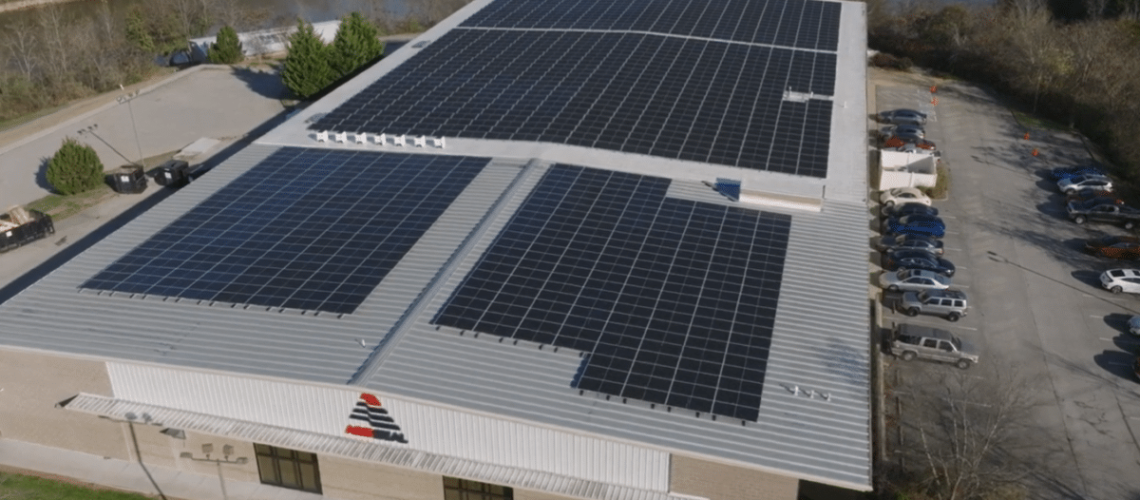Solar Alliance completed the design, engineering, and installation. Plus, REAP grants help rural small businesses save on solar.
Solar Alliance, a residential and commercial solar provider, announced it has completed design, engineering, and installation of a 526 kW rooftop solar array. The project was developed on the roof of a manufacturing site for advanced seal manufacturer AESSEAL.
Once activated, the Rockford, Tennessee rooftop solar installation is expected to provide on-site renewable energy that AESSESAL said will meet the power demand of a large portion of the assembly, quality control, engineering, and customer service divisions. The project is a step along the way toward the company’s goal of achieving net-zero emission.
Commercial rooftop arrays can call for a variety of engineering solutions to best fit the mounting surface. In this design, Solar Alliance used a combination of ballasted and flush mounts to secure the solar modules to the roof. The array is among the largest rooftop installations in the region.
AESSEAL also designs water management systems, that along with seals, help conserve billions of gallons of water and millions of dollars for their customers.
“Water management is another way to meet sustainability goals,” said Chris Staackmann, operations manager, AESSEAL. “We’re committed to our customers; we’re committed to the environment.
Solar Alliance provided the engineering and electrical support for the project, as well as coordination with its East Tennessee based construction crew to install the system, which covers most of the 50,000 square foot facility.
Since it was founded in 2003, Solar Alliance has developed $1 billion of renewable energy projects that provide enough electricity to power 150,000 homes. It has served a wide array of customer sites, including homes, farms, manufacturing sites, professional buildings, data centers, retail centers and utility installations. The company operates primarily in Tennessee and Kentucky, along with North and South Carolina and Illinois.
REAP the benefits
Solar Alliance has developed several projects that qualify for the U.S. Department of Agriculture Rural Energy for America (REAP) Grants. The REAP grant provides grants and low-interest loans for small business owners in rural areas.
The REAP program awards grants between $2,500 and $500,000 for solar projects, energy efficiency grants of $1,500 to $250,000, and a loan and grant combination with an amount exceeding $1,500 for the grant portion. The maximum incentive one can receive within this range is 25% of the total project cost and is anticipated to increase in the near future to 50% of allowable project costs per updated federal programs.
The program is available not just to farmers and small agricultural practices, but to small businesses as defined by the Small Business Administration. Solar Alliance said businesses with 500 or fewer employees have qualified for REAP grants. Eligibility starts with location and is focused on rural areas where 50,000 or fewer people live.
“I think the mission of the grant is very straightforward: Lower your operating costs, become more competitive, sell more products at an equal or improved value, create more jobs, create a larger tax base, grow the community” said Harvey Abouelata, vice president, Solar Alliance.
“I can’t emphasize enough how important it is to spread the word about the grant availability. If the money does not get used in your state, it goes back to the federal fund to get redistributed to other states around the country. This is your tax money; keep it at home working for you,” said Abouelata.
Longtime Loudon County family business Wampler’s Farm Sausage has utilized REAP to support its development of several energy efficiency and solar energy projects. Wampler has since become an ambassador for the benefits of REAP and working with a developer like Solar Alliance.
“It’s important when you have a partner that’s going to come in and do a project for you, that they know not just the technical side of how to install but dealing with the tax credits and the accelerated depreciation, and all the things that are involved in helping you justify the project and know what the payback’s going to be,” said Wampler.



